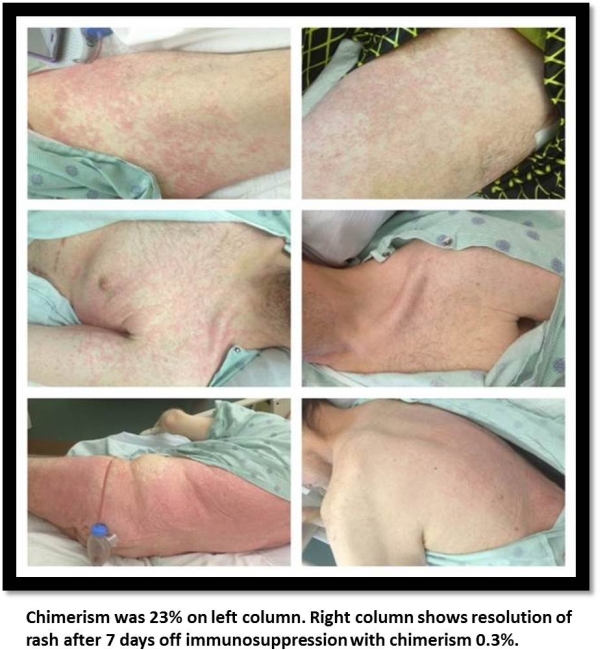Chimerism for Early Detection of Graft Versus Host Disease in Intestinal Transplantation
Miami Transplant Institute, University of Miami Miller School of Medicine, Miami, FL.
Meeting: 2015 American Transplant Congress
Abstract number: A287
Keywords: Graft-versus-host-disease, Immunosuppression, Intestinal transplantation, Mixed chimerism
Session Information
Session Name: Poster Session A: Small Bowel All Topics
Session Type: Poster Session
Date: Saturday, May 2, 2015
Session Time: 5:30pm-7:30pm
 Presentation Time: 5:30pm-7:30pm
Presentation Time: 5:30pm-7:30pm
Location: Exhibit Hall E
Graft versus host disease (GVHD) is a potentially fatal complication after multivisceral transplantation (MVT). By definition, donor cells must be present in the blood of the recipient. Currently we can monitor blood chimerism and almost predict the appearance of GVHD.
Methods: We reviewed all patients who underwent an MVT at our center from January 2013 to December 2014. Four patients had clinical findings of GVHD.
Results: Patients ages ranged from 1.4 to 46 yrs. Two patients were children and 3 were female. Clinical signs of GHVD appeared at a mean of 90 days postoperatively (30-237). In all 4 patients skin rash was the initial manifestation of GVHD. Other sites of involvement included colon (n=2) and bone marrow (n=2). In all 4 patients blood showed T lymphocytes with high degree of donor chimerism prior to clinical signs at 33 days postoperatively (27-43). Removal of immunosuppression was primary treatment in all patients. Two patients had immediate response with resolution of the rash. This was also evident with decreasing T cell chimerism from 21.6 to 1.7% in one patient and from 23.7 to 0.3% in another. One patient showed no clinical improvement off immunosuppression which coincided with rising chimerism from 10.5 to 98%. She later died due to involvement of bone marrow. Of interest, 4th patient had signs of bone marrow suppression intermittently since postoperative day 30. This improved on lower immunosuppression with T cell donor chimerism decreasing from 99% to 54% at which time blood counts improved. She later presented with a rise of T cell donor chimerism to 91% and frank bone marrow aplasia. Skin rash appeared with rise in B cell donor chimerism to 100% and cleared upon discontinuation of immunosuppression. She remains off immunosuppression and is 100% chimeric for both T and B cells.
Conclusions: Serial chimerisms can predict evolving GHVD before obvious clinical signs. Rising chimerism may give the opportunity to stop or decrease immunosuppression before donor cells predominate and rescue therapy with aggressive immunosuppression is needed.
To cite this abstract in AMA style:
Garcia J, Beduschi T, Ruiz P, Tekin A, Fan J, Nishida S, Selvaggi G, Cubley L, Vianna R. Chimerism for Early Detection of Graft Versus Host Disease in Intestinal Transplantation [abstract]. Am J Transplant. 2015; 15 (suppl 3). https://atcmeetingabstracts.com/abstract/chimerism-for-early-detection-of-graft-versus-host-disease-in-intestinal-transplantation/. Accessed December 22, 2025.« Back to 2015 American Transplant Congress
